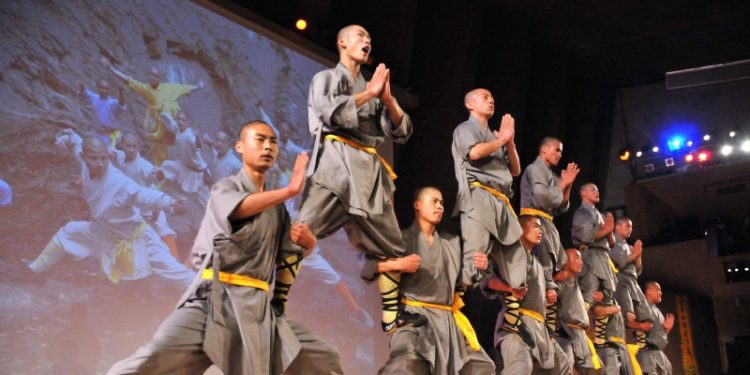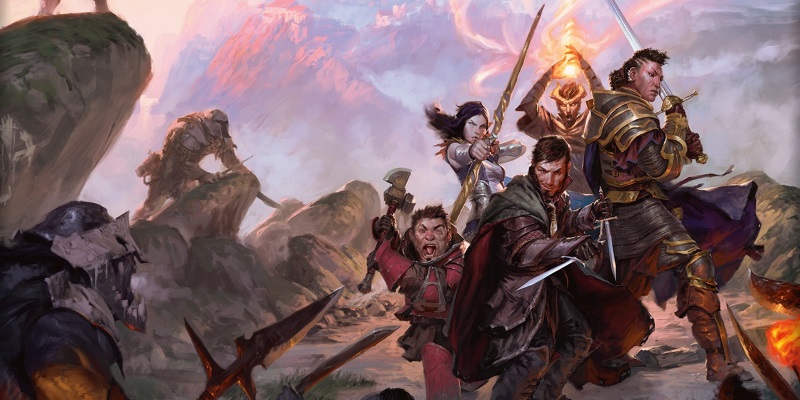The Monk Class, Part One

It’s been, um, a little while now since the History of the Classes column covered character classes rather than social classes. Other than the Warlock, Part Zero, back in October, I haven’t covered classes since February of last year. Thanks for sticking with me, and I hope you’ve enjoyed all of the other things I’ve covered in the intervening time. Today, we’re starting in on the monk, which I can safely call another of the most controversial classes in D&D, and by far the most often banned of the “standard” core classes, according to statistics that I just made up (but based on conversations I see online).
Supplement II: Blackmoor
In 1975, TSR released Supplement II: Blackmoor, following on Supplement I: Greyhawk. Neither of these supplements have much to do with the settings listed in the titles; instead, the twin Demiurges of D&D each released a supplement with a bunch of rules from their own tables. It is, first and foremost, a reminder that D&D has always been a rules-hacking playground. The DM’s Guild page for this product has some great commentary, but nothing could beat Tim Kask’s Vituperative Insult Hour comments on Arneson’s failings as a cogent writer at the time.
All of us started somewhere. Lord knows I wouldn’t care to be held accountable for the game design work I created in my teens and early 20s.
Anyway, the monk. Prior to this point, all of the character classes are explicitly European-friendly; that’s the apple-cart that the monk upsets, and that’s the fundamental reason that it’s so often banned. Because how many “lone traveler from distant exotic lands” can you really have? (Answer: one per campaign should do it.) I don’t really want to get into the issues of race and monoculture that suffuse this 42-year-old conversation, because I’m not real likely to change anyone’s minds. I’ll simply say that D&D has a lot of awkward-fit classes, subclasses, races, and so on, and it’s always been hilariously bad as a history lesson, so maybe let’s just chill. On the other hand, monks have a more narrowly defined social role and origin than most classes, so I would like to see creative energy pumped into diversifying their story beyond “I went to a monastery or dojo and learned stuff, now I wander the world without significant material needs.”
To the one monk in my own campaign, this comment doesn’t apply to you. You did a top-flight job of working with me to create a graceful fit with the rest of the setting.
The original monk, then, is a variant within the cleric class that shares zero features with the cleric, except for saving throws.
- Monks require Str 12+, Dex 15+, and Wis 15+. This is fairly prohibitive, but nowhere near as much so as other exclusive classes.
- Interestingly, the original monk has no alignment restrictions, though they skew heavily toward lawful. It sort of feels like this is the only monk before 4e that actually watched movies about monks, to see that many of them have a trickster nature.
- “Monks must treat treasure as do paladins.” This is a perfect example of awful information presentation, because it presumes you own Supplement I: Greyhawk just to use Supplement II: Blackmoor. It at least makes more sense for all monks to be ascetic than all paladins.
- No armor, but with a scaling AC from class. The base AC of 9 at 1st level means that the overwhelming majority of monks don’t survive 1st level because…
- d4s for Hit Dice, eventually capping at 16d4. Survivability looks like a major problem until the mid-levels, much like for magic-users. That comparison is going to get borne out.
- Monks may use all weapons, oddly enough, and add half their level as a bonus to damage with weapons.
- Or they can fight unarmed, doing very little (1d4) damage with one attack per round at 1st level, scaling up to 4d10 damage with each of four attacks per round at 16th Uh. Yeah, I’m sure using a weapon sounds like a viable alternative. Right. But also, you have terrible damage output to match your near-zero survivability at 1st level, so that’s good.
- The rules explaining attacks per round and such are, with apologies to Tim Kask, total moon language. “…for example if a Grand Master (6th level) is fighting without weapon against an opponent whose dexterity is not of the highest or who is not magically aided the monk will attack twice for each attack his opponent is allowed.” I don’t know what Dexterity has to do with it! Is this explained somewhere else in the impenetrable annals of OD&D? Help me, internet!
- If their unarmed strike hits by 5 or more, they either stun the opponent (75% of the time) for 3d4 turns (so 30-120 minutes… I think? I’m not super clear on OD&D timeframes), or kill them outright (25% of the time).
- Also, their move speed scales with level, nearly tripling over the course of the progression.
- Monks are hard to surprise, and OD&D’s bizarre mechanic where every creature has their own unique mechanic to resist or gain surprise is on full display.
- Monks can open locks, remove traps, listen, climb, move silently/hide in shadows, and moving silently. This is not a typo on my part. “Move/ing silently” is listed twice, the first time pegged to Halfling thief progression, the second time pegged to thief progression.
- At 4th level, monks can speak with animals.
- At 8th level, monks can speak with plants. What’s up, plants?
- At 5th level, monks can feign death, slipping into torpor for (1d6 x monk level) turns. (A turn is 10 minutes.)
- At 6th level, monks gain resistance to ESP – unless I misunderstand, that resistance is functionally 90% + 1% per level above 6th.
- At 7th level, monks gain what later editions call Wholeness of Body, a small 1/day self-heal. This scales slightly with level.
- At 8th level, monks become immune to suggestion and hypnosis.
- At 10th level, monks resolve telepathy used against them as if they have 18 Intelligence, and become immune to Quests and Geasa. (The text says Geases. I, however, know just enough Irish Gaelic to be dangerous. Thanks, years of LARPing!)
- At 13th level, monks gain the terrible Quivering Palm, usable once per week. Once per week, the monk can instantly and with no die roll (apparently) necessary kill a creature that has as many hit dice as the monk or fewer. In theory, you could initiate the Quivering Palm, then wait a number of days up to your monk level before killing the creature. In practice, you probably just decide to kill whatever it is immediately.
- Monks can dodge missile weapons (finally some actual, low-level survivability help!) with a successful save versus Death Ray or Poison (which I think was the cleric’s good save?), and can dodge “magic missiles of any sort” (guys, this is a really ambiguous phrase in D&D) with a successful save versus Staves & Spells.
- Monks otherwise take no effect from any successful save (3.x jargon: Evasion/Mettle) and half damage from a failed save (Improved Evasion).
- Monks have severe restrictions on the magic items they’re allowed to use, and cannot gain hirelings ever, except for short-term gigs. They gain followers at 6th level, with another laundry list of restrictions on who those followers can be.
And that’s the monk. The flowery level titles are in full effect here; I particularly like “Immaculate” at 4th level. They also have to punch their way to the top, from 6th all the way to 16th, and the rules call out the possibility that you are fighting another PC for the level (and, if you win, demoting that PC to your previous level, even stripping them of XP). Monks magically know (“treat as a Geas”) where to find their opponent. I cannot describe how glad I am that the whole “win a duel or you don’t get to level” thing is gone. A casual glance at the values for open-handed damage, attacks per round, and hit points suggests that you could boil the duels down to an initiative roll and pretty much call it good.
A lot of the long-term design trends that only 4e really breaks are in evidence here: unarmed attacks are as good as or better than armed ones (the damage bonus with weapons is a surprise, but a worthless one unless the weapon does multiple dice of damage), a scaling unarmored AC bonus, lots of attacks per round, lots of mental resistance or immunity, a self-heal, several unique agility-related features, and Quivering Palm. The wide range of thieving skills was unexpected, though we will see that later editions’ monks have superior skills to Karl Q. Fighterbro.
All told, and with an exception for 4e, this might be one of the least changed classes in the whole history of D&D, though 5e’s mechanics are cleaner, saner, and better balanced than these by any standard. The standouts, then, are the things that have gone away: opening locks, disarming traps, speaking with animals and plants, and the ultra-crit rules. The OD&D monk is a blend of ninja assassin (surprise advantages, stealth, weapon and unarmed murder powers) and enlightened soul; over the next several articles in this series, this stays the same, save for a lot of tinkering in how to present the “enlightened soul” part.
Rules Cyclopedia
But there’s another monk in OD&D: the Rules Cyclopedia Mystic. It’s pretty similar to the one above, so I’ll take this at high speed:
- A better hit die (d6, woo!)
- XP bonuses from high ability scores! This is stated unnecessarily confusingly; the short version is that mystics need Dex and Wisdom to qualify for the class, but get their XP boost from Strength. It’s weird.
- Mystics must never break an oath. If they do so, they are kicked out of their order, stop gaining levels, and lose one level per year until they complete a “grand quest” to redeem their honor and standing. Harsh.
- To my knowledge so far (I haven’t read the 1e or 2e monks recently enough to recall), this is an idea that falls away from D&D monks completely after this single appearance, but resurfaces in Monte Cook’s Arcana Unearthed, with the oathsworn class.
- Mystics’ unarmed attacks now strike as silver or increasingly powerful magic weapons.
- Mystics can use several fighter combat maneuvers.
- Mystics can opt into an Acrobatics feature. If they do, they suffer a -20% hit to XP earned. There’s a baseline Acrobatics skill that I guess anyone can learn, and then all the extra stuff that mystics can do with it. The baseline is a pretty nebulous “yes you can acrobatics,” along with reducing falling damage by 10 ft. To this the mystic adds what I’ll translate as “ignore difficult terrain on a successful check” and “pass through an enemy’s space.”
- Because just one resolution mechanic would be silly, the rules block offers two options. One of them is sensible (d20, roll under Dex), while the other looks like it was lifted from Chaosium’s BRP system. I dunno.
- Thief abilities are still here; their success chances now make some sense.
- The mystic gets a progression of special mystic abilities, all of which basically resemble things listed in the Supplement II version above. Things move around in level a bit, but the meaningful changes are that Speak with Plants gets dropped for Speak with Anyone, which is an early version of the Tongue of Sun and Moon feature we see in later editions; and Quivering Palm has been switched to Gentle Touch, letting you apply one effect to the target you touch, from a short list. Death is still on the list, along with charm, quest, cureall, or paralysis.
- Also, it’s now once per day, rather than once per week, and the delayed-effect thing is gone. (It’ll be back.)
- The scaling of AC is more powerful, while the scaling of damage is nerfed very slightly (3d12 at the top end, rather than 4d10). They still have four attacks per round.
- The dueling-to-advance thing is still here, but doesn’t kick in until 10th level.
The mystic is a clear improvement over the monk in many areas of clarity and function, but it’s still incredibly hard to survive at the lowest levels and incredibly overpowered at the highest. It doesn’t significantly alter the themes of the monk, other than the punishment for oathbreaking, but it’s a little better at expressing those themes.
Next time in the History of the Monk: Advanced Dungeons and Dragons, First Edition. Judging by what the Wikipedia page on the monk class says, we are in for quite a weird ride, as there are a lot of internal variations at stake here.



